In the lead-up to the 2023 Women’s World Cup, Spain appeared to be a side lacking unity and togetherness. Star players like Mapi León and Patri Guijarro abstained from selection after a fifteen player mutiny following the Euros in 2022, with questions raised over Jorge Vilda’s management. But with the likes of Aitana Bonmatí, Mariona Caldentey, and Ona Batlle back in the fold following the dispute, Spain have been firmly on fire at the World Cup. They’ve lost just one game in their possession-heavy flamboyance, a 4-0 loss to the counter-attacking genius of Japan in the group stage. Since then, Vilda’s team have been untouchable, and now prepare for a World Cup Final. Here is a tactical analysis of Spain at the 2023 Women’s World Cup.
SYSTEM of play: 4-3-3
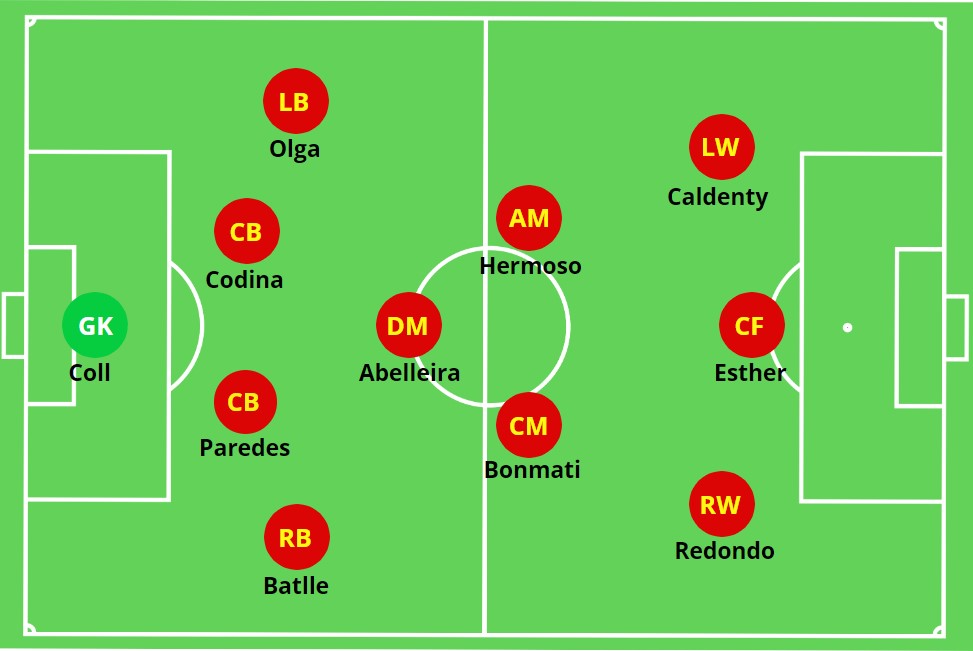
Despite all the potential for chaos and change, Spain have set up in an incredibly consistent 4-3-3, with an incredibly consistent set of players to the Euros last summer. The obvious changes have come through the spine of their team, where goalkeeper Sandra Paños, centre-back Mapi León, and defensive midfielder Patri Guijarro have all been missing. The keeper has turned out to be the most difficult to replace, but Catalina Coll has made the position her own since the knockouts. The tough tackling Laia Codina has come in to try and replace León’s exceptional progression out from the back, while Teresa Abelleira has shifted deeper into the ‘6’ role.
Embed from Getty ImagesThe other massive emergence at this tournament has been the star form of Levante’s Alba Redondo, who surely must be knocking at the door of Barcelona and Real Madrid after her three goals so far.
Embed from Getty ImagesOff the bench, 19-year-old Salma Paralluelo has also made a massive impact, scoring two crucial goals in the last two matches to send Spain to the final.
Embed from Getty ImagesEverywhere else on the pitch, Spain continue their world class talent with names and faces we’ve come to know well. Ona Batlle’s looked comfortably the best fullback in the tournament, seemingly contributing in some way to every single Spain goal. She’s been versatile enough to play on either side throughout the tournament, with Olga Carmona typically holding down the position on the left.
Embed from Getty ImagesIrene Paredes hasn’t missed a beat without her club teammate Mapi León, and Esther González’s been key up front once more. That’s meant a slight positional switch for Jenni Hermoso, playing as the team’s #10 as part of their 4-3-3. Alexia Putellas has then needed to be patient with her return from injury, especially given the brilliance of Aitana Bonmatí on the other side of the midfield.
Embed from Getty ImagesBonmatí’s close control touch of class has been crucial to the Spanish success so far, putting on an absolute clinic with 2 goals and 2 assists and one of the best individual performances against Switzerland.
The flamboyant Mariona Caldentey has completed the attack down the left wing, constantly making herself a threat from wide areas. With that quality across the pitch, it’s easy to see why Spain have achieved so much success. But they’ve also been brilliant with their principles of play across the tournament.
Attacking Principles
Embed from Getty ImagesSpain play with the ball at their feet just as you’d expect from any Spanish side at a World Cup. They’ve preferred to keep the ball on the grass through a range of short and medium passes to cut open the lines of play, predominantly playing through the half-spaces and wide areas with overlapping and underlapping runs from their fullbacks.
Embed from Getty ImagesBatlle in particular loves to get forward, and is fully comfortable inverting inside as the wingers stretch the width. The goal is always to form tightly connected triangles and diamonds between fullbacks, wingers and central midfielders, and progress into those areas without much time wasted.
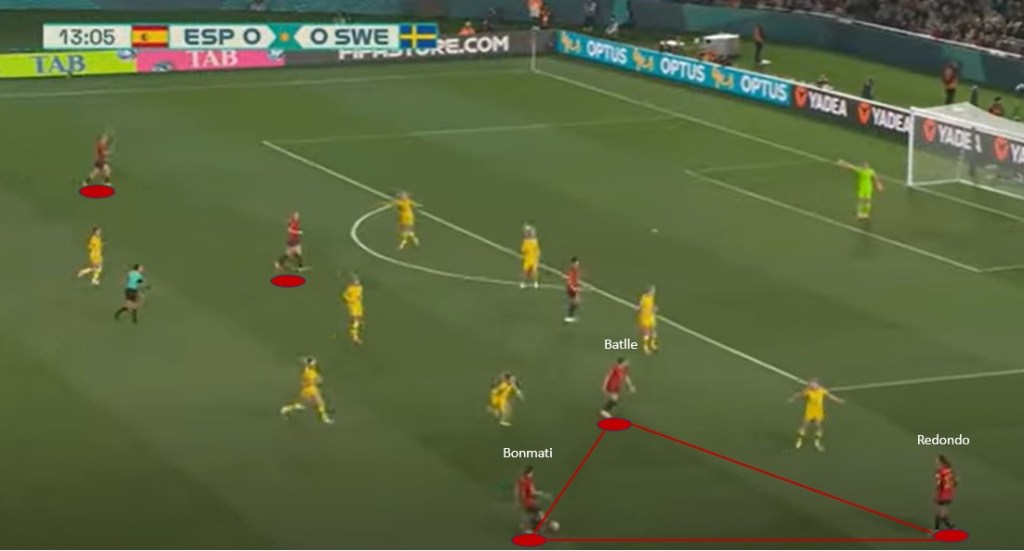
Against Japan, this is where they struggled the most. Japan set up in a resolute 5-4-1, making it incredibly difficult for Spain to cut through the lines and create overloads in those wide areas. Spain’s 77% possession meant very little, as Futoshi Ikeda’s side carved them open on every counter attack as they sprinted in behind Spain’s high-line. However, no other side has been able to replicate that success, and most have been far more open in what they’ve allowed Spain to control.
Embed from Getty ImagesVilda’s team have acclaimed 70.9% of the possession leading into the final, bested only by Germany – who never made it out of the Group Stages. But Spain have had a better passing accuracy than any other side (84%), nicely working the ball through those smooth short passes, and then progressing into the wide areas to create chances from crosses.
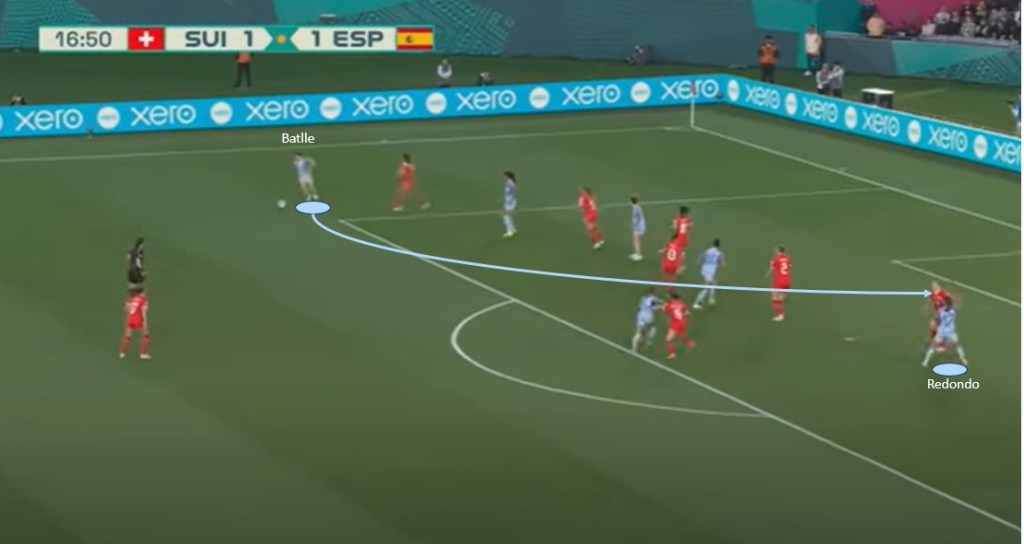
Only France have put up more crosses per game (33) than Spain’s 32. Esther Gonzalez also remains a neat and tidy link-up player, and has a brilliant understanding with Jenni Hermoso in creating close connections in the attack. Through the individual quality they offer, you also shouldn’t be surprised to see all of Spain’s central midfielders coming to one side of the ball to connect. Width is usually maintained by the wings and fullbacks, allowing Spain options in how they shift the defense.
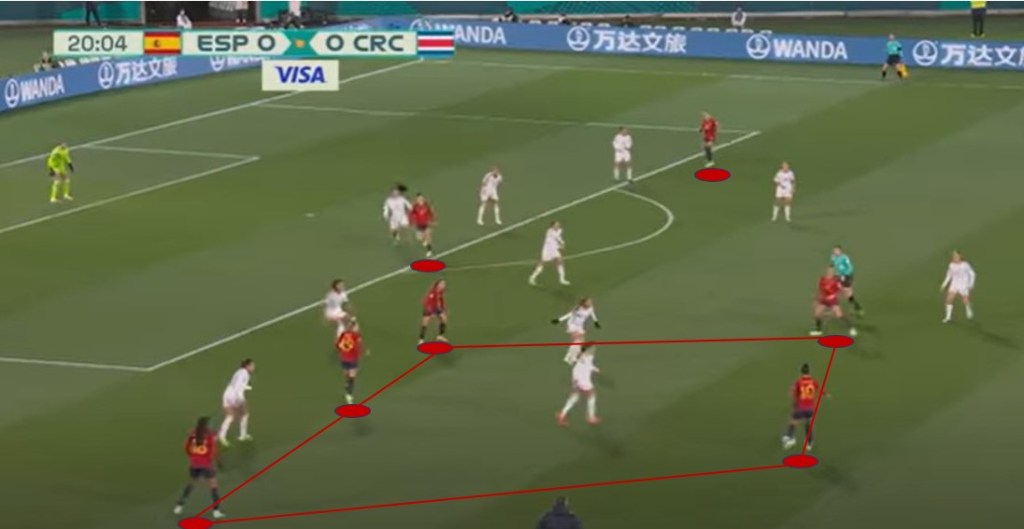
Notice how in this image, the positioning of three Spanish players causes two members of Costa Rica’s back-line to step up away from the others, opening a potential gap for Esther in behind, and a diffusion of responsibility.
There are two main advantages to playing with overloads like these in the wide areas. The first is that you have more numbers to form one-touch connections. You can then move the ball rapidly and cut open the opposition. The second is that you can shift the entire defensive line across in response, thus opening more space on the other side. With both of these options available, Spain can then become a more unpredictable attacking side.
Embed from Getty ImagesOnce they progress into the final third, Spain will compound matters by getting numbers into the box in abundance. Esther will always remain ready for the give-and-go, as the likes of Hermoso and Bonmati wait at the edge of the box for a cut-back or to pick up the loose change.

The quickness at which they attack and get numbers forward can be deadly, but from more patient builds, the sheer number of players they get into the box makes them difficult to stop from crosses.
Embed from Getty ImagesFinally, it’s worth noting the quality of their movement after making passes. The Spanish players are always on the move, and it allows them to quickly combine and move the ball faster than the opposition can react. This is something that all young players can take away from watching the likes of Bonmatí, Redondo and Batlle. Watch the way they pass and immediately move into open space.
For all their possession, they don’t waste time in creating attacks. That is something that has taken Jorge Vilda’s side all the way to the top at this tournament, where they now look like the favourites for the trophy. But as we all know, defense is also essential in winning championships. Other than that blip against Japan, Spain have kept things relatively clean at the back.
Defensive principles
Embed from Getty ImagesThe sign of any good defensive side is the collectiveness by which they exert their energy and force onto the opposition. Spain certainly check that box, swarming around the opposition in numbers, and using their attacking numbers to counter-press in the opposition’s third.
Embed from Getty ImagesNow for all their quality in possession, Spain lack that same sense of true physicality, pace and power in defending quick attacks. They often throw so many numbers forward, including their full-backs and central midfielders, that they can be counter-punched by quick balls over the top and speedy attacks.
The fullbacks can also be susceptible to high balls and crosses into the box, where they lack the height to fully challenge against taller attackers.
Embed from Getty ImagesThis is where a side like Australia or England should look to hurt Spain with the height and power they have in the wide areas, and potentially the pace and power on the break. But no side has been able to sit back and be as compact as Japan, and England will likely want to take the game Spain, which could only leave them more susceptible to Spain’s brilliance on the break.
Embed from Getty ImagesSpain can also be difficult to stop on the defensive end given the way they set up in their 4-3-3, reacting to the opposition’s shape. Take this example against Japan, where they matched up against Japan’s 3+2 to maintain the lion’s share of possession.
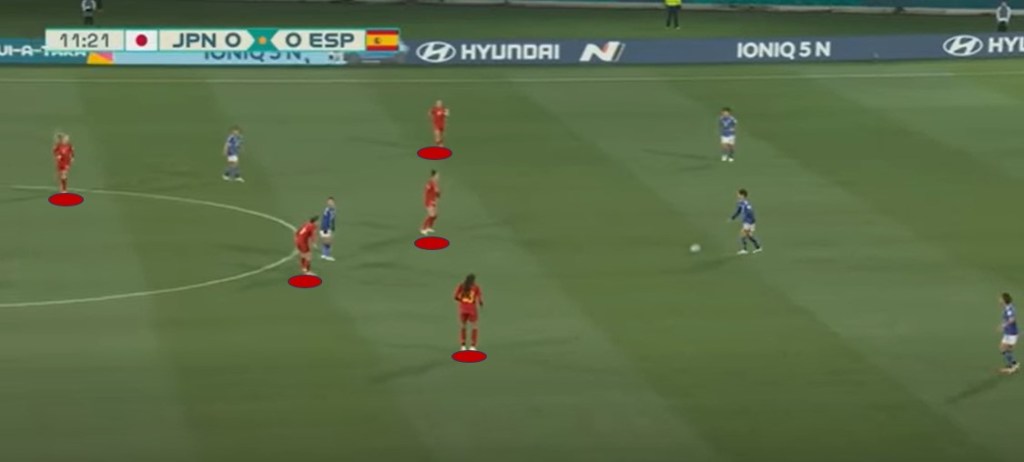
Against Sweden, they typically kept Redondo further back from the other members of the front of the press, so that she could track the movement of Jonna Andersson. Vilda’s ability to remain flexible to the tactical set-up will be essential in the final, ensuring they can limit the opposition’s progression out from the back just as they did against Sweden.
Conclusion
Embed from Getty ImagesEven with their embarrassing loss to Japan, there’s an argument to suggest that Spain have been the best side at the 2023 Women’s World Cup. They’ve certainly had the toughest of draws to get here, having to beat two other tournament favourites in Netherlands and Sweden to break through to the final. They’ve handled those challenges with poise and composure, bringing a mix of experience and young flair to inject life into their attack. Spain will be a tough side to crack for either Australia or England; and at the moment, must be favourites to win it at all.
YOU MIGHT ALSO ENJOY…
Women’s World Cup 2023 – Team of the Tournament
This summer’s Women’s World Cup has been full of drama and entertainment, with several big hitters going out early, and under-established sides making deep runs into the competition. Tournament hosts Australia have certainly made their mark, and the competition on the other side of the bracket with the likes of Sweden, Netherlands and Spain has…
England – Women’s World Cup 2023 – Tactical Analysis
Sarina Wiegman’s England are four games into their World Cup campaign and despite attaining four wins, there remains some skepticism around the nation surrounding how far they can go. Losing there captain Leah Williamson, and 2022 Ballon d’Or nominee Beth Mead to injury, England are having to navigate the biggest competition in world football deprived…
New Zealand – Women’s World Cup 2023 – Tactical Analysis
After a promising start to the 2023 Women’s World Cup, New Zealand crashed out of the tournament due to a narrow defeat in the second round against the Philippines. With Norway putting six past the Philippines in the next match, New Zealand’s lack of goals meant they were never going to advance on goal-difference, even…





One thought on “Spain – Women’s World Cup 2023 – Tactical Analysis”